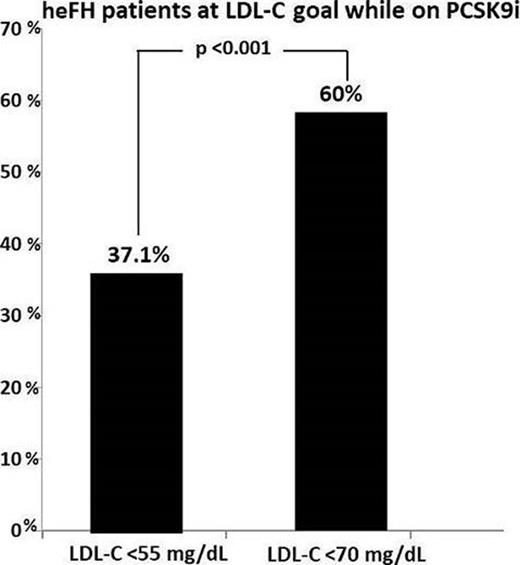-
PDF
- Split View
-
Views
-
Cite
Cite
L Rallidis, C Vlachopoulos, E Liberopoulos, I Skoumas, E Kiouri, I Koutagiar, G Anastasiou, N Kosmas, D Tousoulis, E Iliodromitis, The new LDL-C target <55 mg/dL is achieved by less than 40% of very high risk patients with familial hypercholesterolaemia despite receiving PCSK9 inhibitors: real world data, European Heart Journal, Volume 41, Issue Supplement_2, November 2020, ehaa946.2999, https://doi.org/10.1093/ehjci/ehaa946.2999
Close - Share Icon Share
Abstract
The recently published ESC/EAS guidelines for the management of dyslipidaemias have lowered the low-density lipoprotein cholesterol (LDL-C) target in the very high risk patients below 55 mg/dL.
To examine how achievable is this target in very high risk patients receiving a proprotein convertase subtilisin/kexin type 9 inhibitor (PCSK9i) on top of lipid-lowering treatment (LLT).
The cohort comprised 158 patients who attended the lipid clinic of 3 hospitals in Greece and started treatment with PCSK9i. Patients were requested to attend the lipid clinic 3 months after the initiation of PCSK9i.
Ninety percent of patients had heterozygous familial hypercholesterolaemia (heFH) and 75% had cardiovascular disease (CVD). One hundred forty patients were classified as very high risk because they had either cardiovascular disease (CVD) or heFH with an additional risk factor for whom a target <55 mg/dL is currently recommended. Of those very high risk patients, 105 (75%) were given PCSK9i due to failure to achieve LDL-C targets despite maximum LLT (high intensity statin at maximum tolerated dose + ezetimibe) while in the rest of cases the indication was statin intolerance. The mean reduction of LDL-C at 3 months was 56.2%. Among 105 very high risk patients (all had heFH), LDL-C below 55 mg/dL was achieved by 37.1% while the previously LDL-C target <70 mg/dL was achieved by 60% (Figure 1).
The new LDL-C target <55 mg/dL is achieved by <40% of very high risk patients with heFH despite receiving triple LLT, i.e. PCSK9i + statin + ezetimibe. This therapeutic gap suggests that there is still need for more effective LLT in very high risk heFH patients to maximize their clinical benefit.

Figure 1
Type of funding source: None
- dyslipidemias
- pharmacotherapy
- ldl cholesterol lipoproteins
- statins
- cardiovascular diseases
- familial hypercholesterolemia
- familial hypercholesterolemia-heterozygous
- greece
- maximum tolerated dose
- guidelines
- lipids
- ezetimibe
- pcsk9 gene
- european society of cardiology
- pcsk9 inhibitors
- statin intolerance
- proprotein convertase 9



